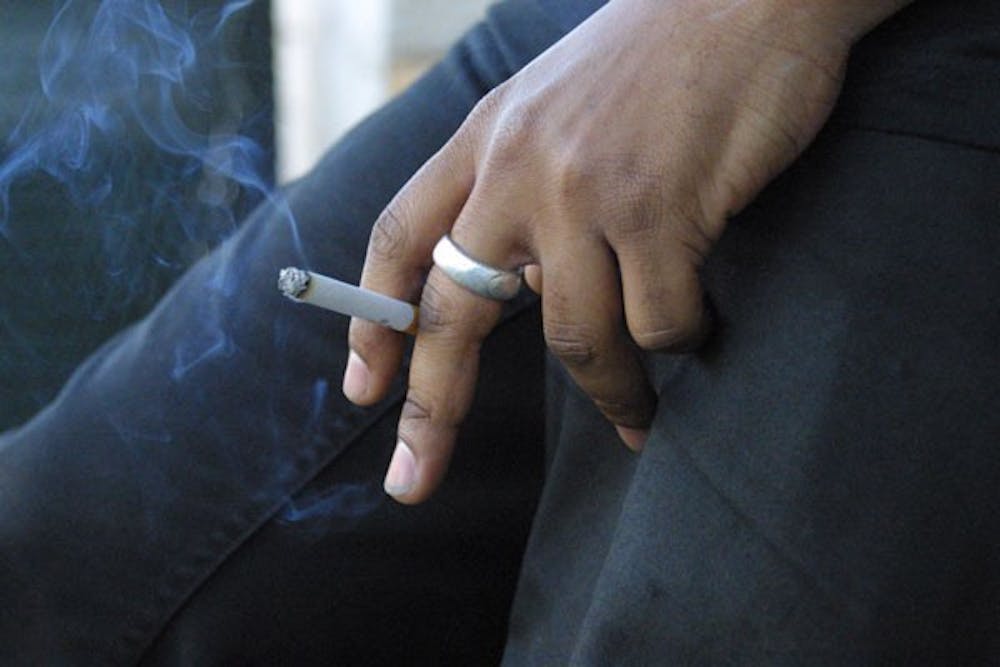With more than six years invested in his research, ASU professor Hugo Destaillats is making new findings in the effects of third-hand smoke.
The research has found that third-hand smoke complicates the dangers of second-hand smoke, which is already recognized as able to cause cancer.
“If you can smell [the cigarette smoke], there is something there that goes from the surfaces to your [senses],” Destaillats said. “That is third-hand smoke.”
The research, performed at Lawrence Berkeley National Laboratory in Berkeley, Calif., revealed how nicotine reacts with pollutants in the air when it lingers on indoor surfaces and can affect people even after the smoke is long gone.
“Because of the reactions that can occur on the surfaces, third-hand smoke can become more dangerous over time as it interacts with the common pollutant nitrous acid,” said staff scientist at the Lawrence Berkeley National Laboratory Lara Gundel.
Destaillats, Gundel and other researchers began this exposure assessment by testing how nicotine reacted with the ozone. After investigating the reactions, the research took a turn.
“We were very curious about whether pollutants that would be normally or often present indoors would react with cigarette smoke that would linger on the surfaces of indoor environments that people would be smoking [in],” Gundel said.
While tobacco burns, the nicotine it releases is in a vapor form, which can easily cling to surfaces like floors, carpeting, drapes and furniture.
“We started looking at what happens after the smoke leaves, in other words, when somebody [finishes] smok[ing], time passes and smoke gradually dissipates and part of it sticks on surfaces,” Gundel said.
When nicotine mixes with the common pollutant nitrous acid, it produces harmful carcinogens known as tobacco-specific nitrosamines or TSNAs.
“We found that … these nasty carcinogens were formed on the surfaces from levels of nitrous acid that would be present indoors,” Gundel said.
Destaillats and Gundel also looked at what occurs inside the truck of a smoker and found high levels of TSNAs.
“Vehicles have a lot of surfaces that people can be exposed to,” she said.
Though their research found evidence of dangerous components indoors, it’s unknown how they get into or affect the body.
“We are hoping to be able to give [this research] to biologists so they can follow up on these studies and find out what these carcinogens do when they [enter the body],” Gundel said.
It’s also unknown whether third-hand smoke directly causes cancer, she said.
“Nobody knows that just yet,” Gundel said. “One of the complications is that before third-hand smoke was recognized, a lot of [diseases that were] contributed to second-hand smoke, may have been caused by third-hand smoke, but we don’t know that yet.”
This research makes Gundel assume it does lead to cancer.
“Two of the three compounds are very potent carcinogens based on work done by biologists … and they are thought to be linked to lung cancer,” she said.
While assumptions may lead to cancer, Destaillats made it clear that it’s still an unknown topic.
“Sometimes people take … research like ours and they make wild extrapolations,” he said. “There is a potential harm, but we don’t want to exaggerate it.”
If the research does lead to third-hand smoke resulting in cancer, mathematics graduate student Susan Seal said she still wouldn’t change her smoking habits.
“I think it’s all pretty much a stretch,” Seal said. “Certainly me smoking in my car is no worse for me than the fact that I’m already smoking.”
Photography sophomore Airi Katsuta said she never smokes in her house, but does smoke in her car four or five times a day.
Katsuta said the research makes her more aware of the non-smokers around her.
“[They’re] not even around smoke and can get cancer — that’s bad,” she said.
While Destaillats and Gundel’s research has made some think twice, both said this wasn’t their goal.
“We want people to know that we have identified a risk from tobacco smoke that has never been recognized before,” Gundel said.
Reach the reporter at katelyn.bolnick@asu.edu





